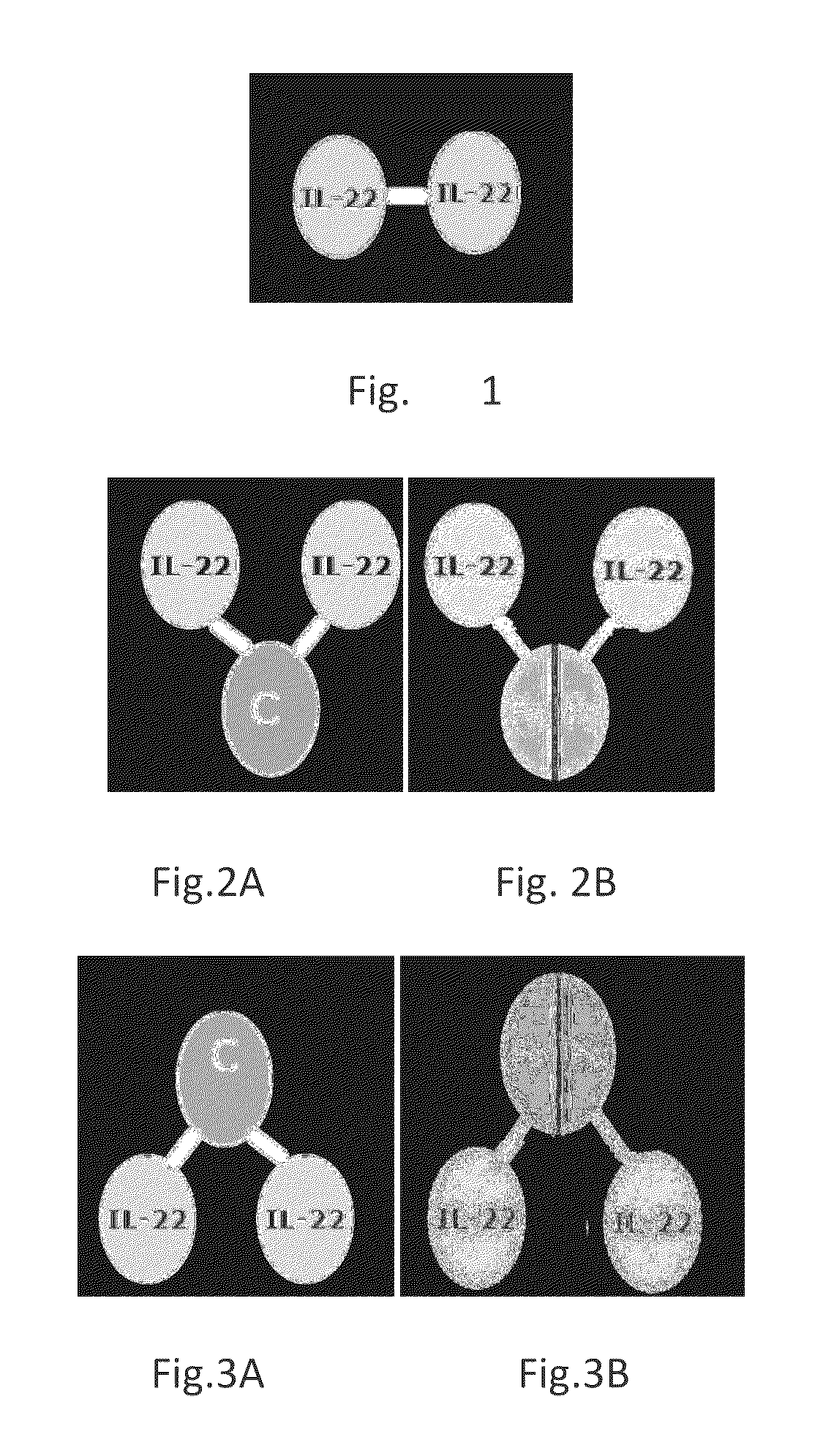Uses of interleukin-22(IL-22) in treating and preventing nerve damage diseases or neurodegenerative diseases
a technology of interleukin-22 and neurodegenerative diseases, applied in the field of biology and medicine, can solve the problems of affecting the function of neurons, so as to enhance the function of dopaminergic neurons, enable recovery of damaged neurons, and prevent the effect of nerve damag
- Summary
- Abstract
- Description
- Claims
- Application Information
AI Technical Summary
Benefits of technology
Problems solved by technology
Method used
Image
Examples
example 1
[0107]The IL-22 dimer with the structure described in FIGS. 1-3 having an amino acid sequence of SEQ ID NO: 1 or comprising monomers with amino acid sequences as shown in SEQ ID NOs: 2-5, is prepared and purified by conventional methods. For example, the IL-22 dimer comprising IL-22-Fc complexes was prepared. Preparation methods are described as follows:
a. Construction of a Cell Line Expressing IL-22 Dimer
[0108]The cDNA sequences encoding IL-22-Fc complexes (as shown in SEQ ID NO: 6 or SEQ ID NO: 7, wherein SEQ ID NO: 6 encodes the monomer shown in SEQ ID NO: 2, and SEQ ID NO: 7 encodes the monomer shown in SEQ ID NO: 3) were synthesized. The cDNA sequence of human IL-22 monomer was connected with the cDNA sequence of Fc fragment of IgG2. EcoRI site and components required for mammalian cell expression such as Kozak sequence and signal peptide sequence were introduced at the 5′ end, while XbaI site was introduced at the 3′ end. It was cloned into a commercially available pUC19 plasm...
example 2
In Vivo Half-Life of IL-22 Dimer
[0111]Rats received a single subcutaneous injection of IL-22 dimer (consisting of two IL-22-Fc monomers comprising a sequence shown in SEQ ID NO: 2) with a dosage of 100 μg / kg. The pharmacokinetic parameters were calculated and listed in Table 1 below (n=6). The in vivo half-life of IL-22 monomer (recombinant human IL-22) in rats was approximately 1.3 hr.
[0112]
TABLE 1Parameter (n = 6)UnitAverage ValueSDAUC(0-t)ng / mL * h4216.7638.3MRT(0-t)h22.61.6t(1 / 2)h7.81.3Clz / FL / h / kg0.0280.003Cmaxng / mL153.226.2
example 3
Effect of IL-22 or IL-22 Dimer on STAT3 Activation in Neurons
[0113]Fetal rat brain was harvested from female SD rats at the 17th day of gestation, and then placed in pre-chilled D-Hanks solution. Cerebral cortex without meninx was carefully removed under dissection microscope and cut into small pieces of approximately 1 mm3. The minced cortex was digested in 10 mL of 0.125% of trypsin, at 37° C. for 15 min. Then the tissue was aspirated and transferred into pre-chilled centrifuge tubes containing DMEM containing 10% FBS, and pipetted for a few times with a pipettor to stop the trypsin digestion. After standing, the supernatant was obtained and aspirated into another centrifuge tube. Such steps were repeated for 2-3 times.
[0114]The cells were cultured in serum-free neuron basal medium (Invitrogen, Cat: 21103049) with serum-free additive of B27 (Invitrogen, Cat: 17504044) for 8 days. The medium was replaced once every two days.
[0115]After 8 days of culture, the neurons were treated wi...
PUM
| Property | Measurement | Unit |
|---|---|---|
| UV absorption wavelength | aaaaa | aaaaa |
| concentration | aaaaa | aaaaa |
| concentration | aaaaa | aaaaa |
Abstract
Description
Claims
Application Information
 Login to View More
Login to View More - R&D
- Intellectual Property
- Life Sciences
- Materials
- Tech Scout
- Unparalleled Data Quality
- Higher Quality Content
- 60% Fewer Hallucinations
Browse by: Latest US Patents, China's latest patents, Technical Efficacy Thesaurus, Application Domain, Technology Topic, Popular Technical Reports.
© 2025 PatSnap. All rights reserved.Legal|Privacy policy|Modern Slavery Act Transparency Statement|Sitemap|About US| Contact US: help@patsnap.com



